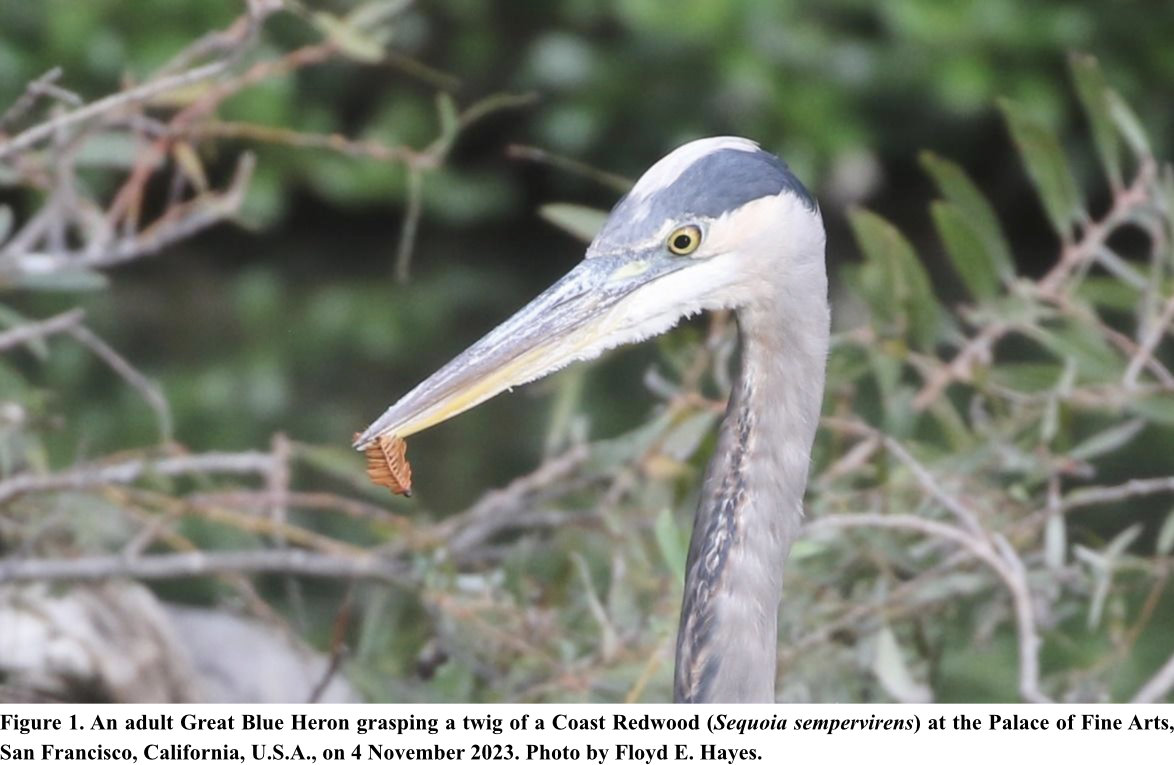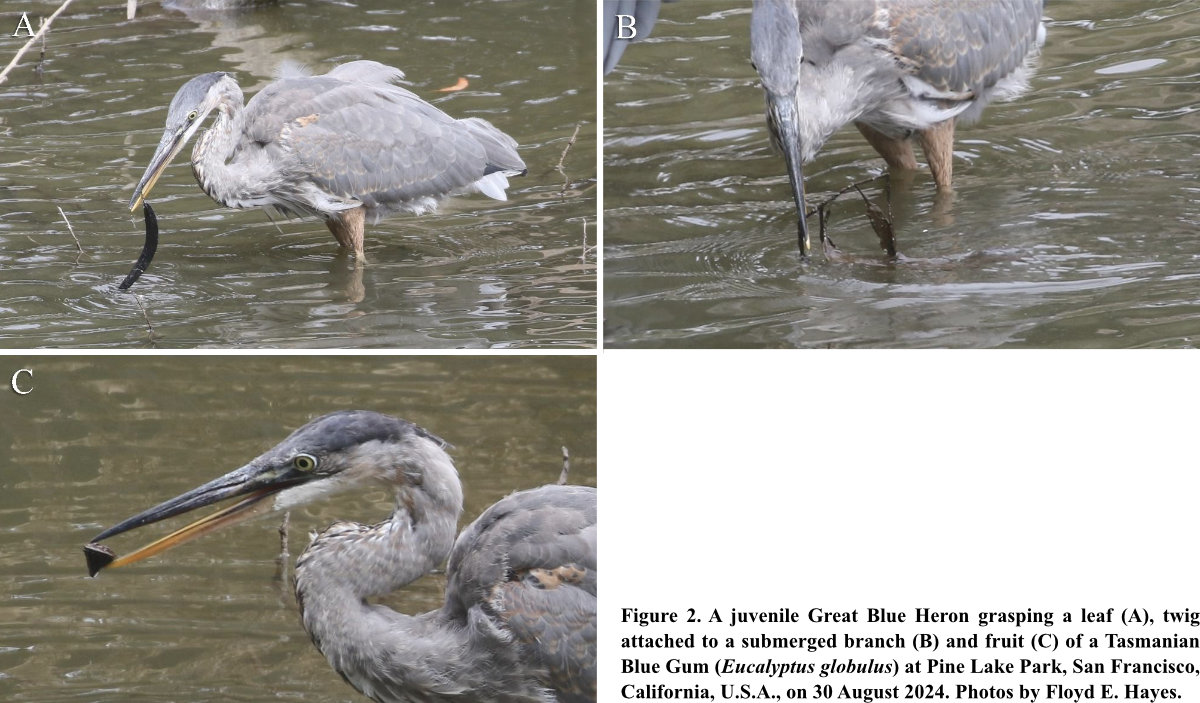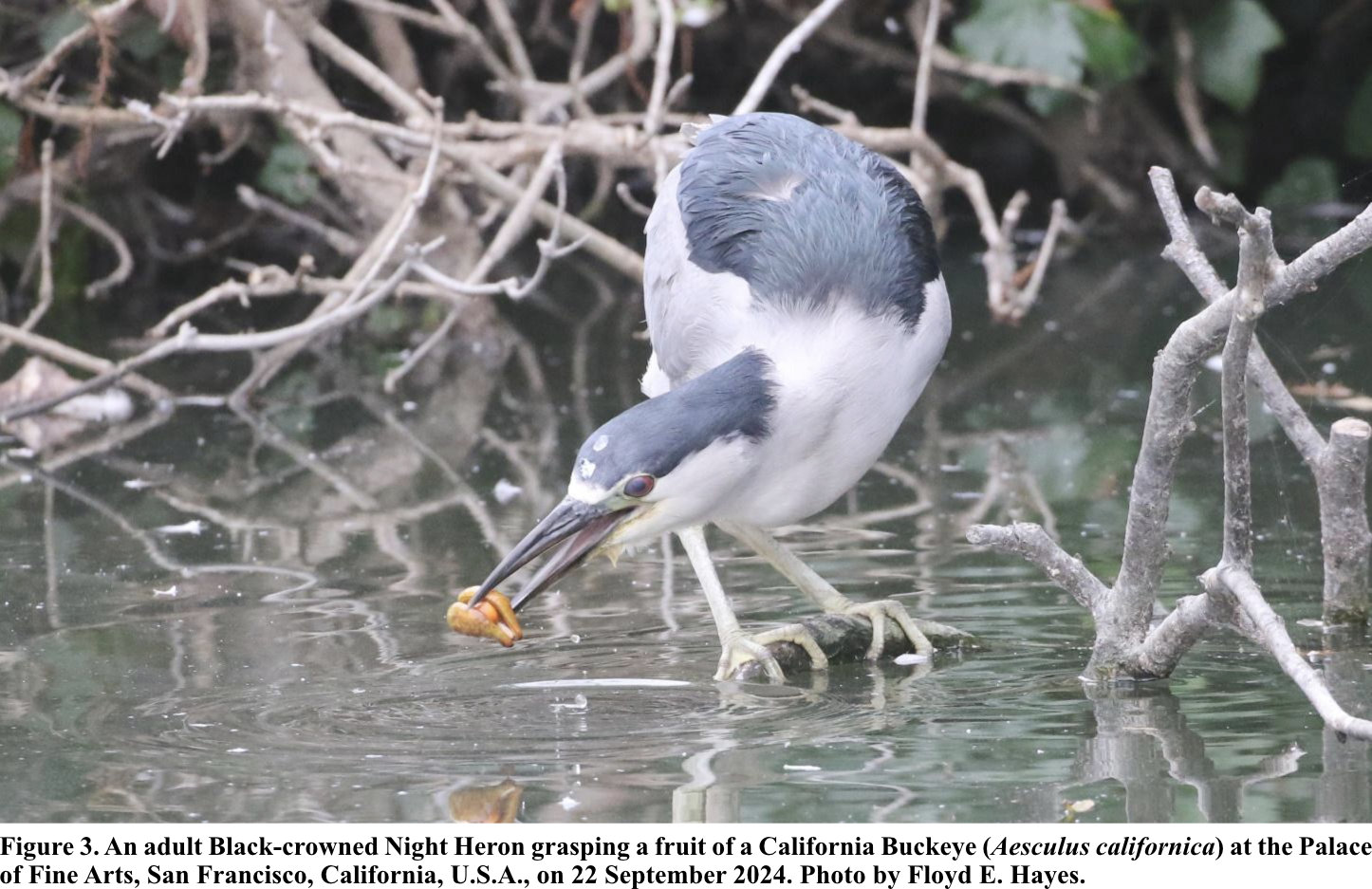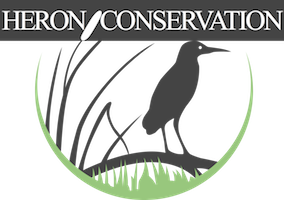Manipulation of vegetation while foraging by the Great Blue Heron (Ardea herodias) and Black-crowned Night Heron (Nycticorax nycticorax): Object play, bait fishing or flush-pursuit foraging?
Abstract
Six species of herons have been reported using vegetation (inedible plant parts) as tools to enhance foraging, usually for bait fishing but also for flush-pursuit foraging. I document three new cases of herons manipulating vegetation while foraging in San Francisco, California, U.S.A., including: (1) an adult Great Blue Heron (Ardea herodias) using a twig while foraging, probably for active bait fishing; (2) a juvenile Great Blue Heron lifting branches and using leaves and fruits, probably for flush-pursuit foraging; and (3) an adult Black-crowned Night Heron (Nycticorax nycticorax) using a leaf and a fruit, possibly for flush-pursuit foraging. Flush-pursuit foraging had not been previously reported for these species. Given the difficulty distinguishing between play, bait fishing and flush-pursuit foraging as potential functions for manipulating vegetation while foraging, these interpretations are tentative.
Key words: Ardeidae, Ardea herodias, foraging behavior, Nycticorax nycticorax, tool use.
Introduction
Herons of the family Ardeidae use a wide variety of methods for capturing prey, including the use of edible bait and inedible lures as tools for capturing fish (Kushlan 1976, 1978, Kelly et al. 2003, Kushlan and Hancock 2005). Nestling, fledgling and immature herons have been reported playing with inanimate objects, such as twigs and leaves, when not foraging or when practicing foraging (Butler 1992, Telfair and Raymond 1994, Davis 2001, Sazima 2008, Combs and Réglade 2022). Such play behavior is thought to promote the use of tools to enhance foraging later in life (Davis 2001, Sazima 2008, Combs and Réglade 2022).
The use of vegetation (inedible plant parts) as tools to enhance foraging has been reported in at least six species of herons. Little Herons (Butorides atricapilla) used a flower for bait fishing in Burkina Faso, West Africa (Walsh et al. 1985) and twigs, leaves, berries, bark, roots and moss for bait fishing in Japan (Higuchi 1986, 1988). Striated Herons (Butorides striata) used twigs, leaves, seeds and flowers for bait fishing in Peru (Robinson 1994). A Goliath Heron (Ardea goliath) used a twig for bait fishing in Tanzania (Hunter et al. 2004). A Great White Heron (Ardea herodias occidentalis), currently recognized as a subspecies of the Great Blue Heron (Chesser et al. 2020) but may eventually be recognized as a distinct species (Browning and Kushlan 2022), used twigs for bait fishing in Florida, U.S.A. (Evans and Jackson 2019). A Black-crowned Night Heron (Nycticorax nycticorax) used a twig for bait fishing in Vietnam (Combs and Réglade 2022). And a Great Egret (Ardea alba) lifted, shook and dropped branches to flush and pursue prey in Kansas, U.S.A. (Sneegas and Newmark 2024).
In this note, I document additional cases of vegetation manipulated while foraging by the Great Blue Heron (Ardea herodias) and Black-crowned Night Heron and discuss whether the behavior represents play, bait fishing or flush-pursuit foraging. I provide evidence that a case of an adult Great Blue Heron represents active bait fishing, a case of a juvenile Great Blue Heron represents flush-pursuit foraging and a case of an adult Black-crowned Night Heron may represent flush-pursuit foraging. The latter two cases represent previously unreported foraging methods for these species.
Observations
Great Blue Heron #1
At 15:57 hr on 04 November 2023, I was photographing an adult Great Blue Heron wading in a lake at the Palace of Fine Arts, San Francisco, California, U.S.A. (37° 48ʹ 13″ N, 122° 26ʹ 53″ W), when I noticed it pick up a small twig with dead leaves of a Coast Redwood (Sequoia sempervirens). It grasped the twig in its beak (Fig. 1), dropped it into the water and stared at it intently for about 2 min without striking the water before wading away from it. I was unable to linger longer to observe any subsequent foraging activity.

Great Blue Heron #2
At 12:03 hr on 30 August 2024, I noticed a juvenile Great Blue Heron picking up and dropping inanimate objects in its bill as it waded in shallow water amongst partially submerged limbs of a large Tasmanian Blue Gum (Eucalyptus globulus) that had recently fallen into Pine Lake at Pine Lake Park, San Francisco, California, U.S.A. (37° 44ʹ 09″ N, 122° 29ʹ 21″ W). To document the heron’s foraging behavior, I took 137 photos during the next 10 min, after which it ceased foraging and climbed up onto an emergent branch of the tree. The heron performed the following behavioral acts with inedible parts of the tree (unless stated otherwise) in sequence: (acts 1-2) picked up a floating dead leaf above the surface and dropped it twice (Fig. 2a); (act 3) lifted a submerged twig, with two attached leaves and attached to a larger branch beneath, above the surface and dropped it (Fig. 2b); (act 4) lifted another submerged branch slightly above the surface and dropped it; (act 5) picked up two floating fruits above the surface and dropped them; (acts 6-13) picked up another floating fruit above the surface and dropped it eight times (Fig. 2c); (act 14) lifted a submerged branch slightly above the surface and dropped it; (acts 15-20) picked up a floating fruit above the surface and dropped it six times; (act 21) picked up a floating small, dead leaf with smooth margins above the surface and dropped it; and (acts 22-23) picked up a floating fruit above the surface and dropped it twice. I do not know how many such behavioral acts occurred before I started taking photos and it is possible that I failed to photograph one or more behavioral acts during the sequence. After each object was dropped, the heron usually struck immediately, within 1-2 sec, into the water at a variable distance of approximately 0.2-1 m from the dropped object. Although the head was often completely submerged during strikes and water gushed out of a slightly open bill when it was lifted out of the water, my photographs did not document any captured fish.
I returned to the site 2 days later, on 1 September 2024. The juvenile Great Blue Heron was absent, but two adults were present; however, neither was observed foraging.

Black-crowned Night Heron
At 09:14 hr on 22 September 2024, I observed an adult Black-crowned Night Heron pick up and drop a green leaf at the edge of a lake at the Palace of Fine Arts, San Francisco, California, U.S.A. (37° 48ʹ 13″ N, 122° 26ʹ 51″ W). The heron was perched at water level on the branch of a small, dead, partially submerged tree. I immediately pulled out my camera and obtained 34 photos during the next 3 min (09:15-09:18) as it initially struck at the water and then repeatedly picked up the floating fruit of a California Buckeye (Aesculus californica) tree above the surface of the water and immediately dropped it (Fig. 3). I did not photograph every act of the sequence, but estimate it was repeated 10 times, with each sequence lasting about 20 seconds on average. About halfway through the sequence, the seed separated from the fruit; the seed disappeared, and the heron continued manipulating the fruit. The heron remained on its perch throughout the sequence and dropped the fruit or seed in the water on both sides of the branch. Immediately after dropping the fruit during each sequence, the heron stared intently into the water near the fruit, but did not strike at the water again after my initial photographs. I did not observe or photograph it catching a fish.

Discussion
Potential Functions
Three potential functions have been proposed for herons manipulating vegetation when not nest building: (1) object play, (2) bait fishing and (3) flush-pursuit foraging. Distinguishing between these functions may be difficult when attempting to interpret the function of a heron manipulating vegetation.
Play behavior, including locomotor play, object play and social play, has been documented in a variety of bird species (Ficken 1977, Ortega and Bekoff 1987, Diamond and Bond 2003, Burghardt 2005, Emery and Clayton 2015, Kaplan 2020). Object play, which refers to the manipulation of an object for no apparent survival function, has been reported in fledgling, nestling and immature herons, but not by adults, of four species. Nestling and fledgling Western Cattle Egrets (Ardea ibis) reportedly stabbed at inanimate objects, but no further details were provided (Telfair and Raymond 1994, Telfair 2024). Nestling and fledgling Great Blue Herons also reportedly stabbed at inanimate objects, without further details (Butler 1992). An immature Great Blue Heron successfully ”captured” pieces of plants 70 times and failed to ”capture” anything during 20 strikes within 12 min in Florida; because it extensively manipulated the vegetation in its bill, its behavior was interpreted as play rather than bait fishing (Davis 2001). Juvenile Striated Herons repeatedly picked up and dropped small pieces of wood, fruits and an insect without attempting to capture any fish while perched on branches above the water in Brazil (Sazima 2008). An immature Black-crowned Night Heron repeatedly chased, grabbed and pushed sticks in France, and an adult repeatedly picked up and dropped a 20 cm stick in Hong Kong; these observations were interpreted as early and more advanced stages, respectively, of play-learning (Combs and Réglade 2022).
Sazima (2008) listed five criteria typical of play behavior: (1) repetitive, awkward or exaggerated; (2) being incomplete or in reordered sequences; (3) being quick and energetically expensive; (4) lacking final consummatory acts; and most importantly, (5) having no obvious immediate function. The criterion of play having no obvious immediate function excludes foraging, but transitional stages between play and foraging may occur, as suggested for the observations described above of the Great Blue Heron (Davis 2001) and Black-crowned Night Heron (Combs and Réglade 2022).
Bait fishing is a form of tool use that occurs when a buoyant object is placed on the water within striking distance and the object attracts or distracts prey, enhancing foraging efficiency (Ruxton and Hansell 2011). The object may be either edible (as bait) or inedible (as a lure) for the prey, and the object may be placed into the water by the bird (active bait fishing) or by another means (passive bait fishing) (Davis and Zickefoose 1998, Ruxton and Hansell 2011). Bait fishing has been documented in at least 14 species of birds, including nine species of herons (Davis and Zickefoose 1998, Ruxton and Hansell 2011, Réglade et al. 2015), plus a tenth species of heron, the Great White Heron (Evans and Jackson 2019), if it is recognized as a distinct species (Browning and Kushlan 2022).
Flush-pursuit foraging was recently described as a unique foraging behavior in herons by Sneegas and Newmark (2024), who documented a Great Egret repeatedly lifting, shaking and dropping a partially-submerged branch out of the water and then rapidly striking the water for fleeing prey in Kansas, U.S.A. Although no fish was captured, the heron appeared to be attempting to flush fish sheltering under the branch. Subsequent experiments in a pool demonstrated that fish rapidly scattered when a branch was lifted, shaken and dropped (Sneegas and Newmark 2024). Flush-pursuit foraging may be most likely to occur when fish prey seek shelter under submerged or partially submerged vegetation.
Interpretations
During my first observation of a Great Blue Heron manipulating vegetation, a twig was dropped into the water and stared at for 2 minutes before the heron walked away. The heron did not exhibit any of the criteria for play other than lacking a final consummatory act; instead, it appeared to be waiting for prey to approach the twig and abandoned the twig when it failed to attract prey. Thus, active bait fishing appears to be the most likely function for dropping the twig. Passive bait fishing with bread was previously reported for an adult Great Blue Heron in Virginia, U.S.A. (Zickefoose and Davis 1998), and active bait fishing with a twig was previously reported for a Great White Heron (subspecies of Great Blue Heron) of unknown age in Florida, U.S.A. (Evans and Jackson 2019).
During my second observation of a Great Blue Heron manipulating vegetation, the heron repeatedly struck at the water as though it was actively foraging rather than playing. It repeatedly lifted a twig or branch above the surface in a fashion similar to the flush-pursuit foraging Great Egret described by Sneegas and Newmark (2024). And it repeatedly picked up and dropped fruits and a leaf, but instead of waiting for it to strike at prey near the floating object, which would be expected if it were bait fishing, it often struck immediately at the water at distances of up to 1 m from the object. Although I did not observe or photograph any fish captured by the heron, I found and photographed a few hundred introduced Western Mosquitofish (Gambusia affinis), which is a small species with a maximum length of 7 cm (Froese and Pauly 2025), in shallow water along the shore of the lake about 115 m from the foraging heron. To test whether the mosquitofish would be attracted to or scattered by a dropped fruit of the Tasmanian Blue Gum, I dropped a fruit from a height of 1 m above a school of mosquitofish on ten occasions. The mosquitofish immediately scattered away from the fruit nine times and a few mosquitofish swam toward the fruit once. I also dropped a small twig (10-15 cm) from 1 m above a school of mosquitofish and on each occasion the mosquitofish scattered from the twig. The results of both of these experiments are incompatible with bait fishing. In conclusion, the heron most likely manipulated vegetation to flush mosquitofish sheltering under the partially submerged tree limbs and strike at fleeing mosquitofish. Given the small size of the mosquitofish, it is possible that one or more were captured and immediately swallowed without being observed or photographed. The evidence suggests that this heron engaged in flush-pursuit foraging, which is previously unreported for the Great Blue Heron.
Interpreting the function of the Black-crowned Night Heron manipulating vegetation is more difficult. It did not attempt to capture any prey after an initial strike that I photographed, suggesting it was simply playing with the fruit; however, it peered intently into the water and did not manipulate the fruit in its bill, suggesting that it was searching for prey instead of playing with the fruit. Because it never waited long (about 20 sec on average) for a fish to be attracted to the fruit before picking it up and dropping it again, it probably was not bait fishing. Given the repeated dropping of the fruit on both sides of its perch, it may have been attempting to flush prey sheltering beneath the partially submerged tree during an unsuccessful attempt at flush-pursuit foraging, which is previously unreported for the Black-crowned Night Heron.
Because of the difficulty distinguishing between play, bait fishing and flush-pursuit foraging as potential functions for manipulating vegetation while foraging by herons, these interpretations are tentative. Given the novel interpretation of herons manipulating vegetation for flush-pursuit foraging (Sneegas and Newmark 2024), some of the previous reports interpreted as play or bait fishing could potentially be reinterpreted as flush-pursuit foraging. More detailed documentation of herons manipulating vegetation is needed to better understand the underlying functions of the behavior.
Literature Cited
Browning, M. R. and J. A. Kushlan. 2022. The Great White Heron is a species. Journal of Heron Biology and Conservation 7: 1. [online].
Burghardt, G. M. 2005. The Genesis of Animal Play: Testing the Limits. MIT Press, Cambridge, Massachusetts, U.S.A.
Butler, R. W. 1992. Great Blue Heron (Ardea herodias). In The Birds of North America, no. 25 (A. Poole and F. Gill, eds.). The Academy of Natural Sciences, Philadelphia, Pennsylvania, U.S.A. and The American Ornithologists’ Union, Washington, D.C., U.S.A.
Chesser, R. T., S. M. Billerman, K. J. Burns, C. Cicero, J. L. Dunn, A. W. Kratter, I. J. Lovette, N. A. Mason, P. C. Rasmussen, J. V. Remsen Jr. and D. F Stotz. 2020. Sixty-first supplement to the American Ornithological Society’s check-list of North American birds. Auk: Ornithological Advances 137: 1-24.
Combs, B. P. and M. A. Réglade. 2022. Black-crowned Night Heron (Nycticorax nycticorax) bait-fishes with an inedible lure in Vietnam. Journal of Heron Biology and Conservation 7: 5. [online].
Davis, W. E. Jr. 2001. ”Practice” foraging by a sub-adult Great Blue Heron. Florida Field Naturalist 29: 88-89.
Davis, W. E. Jr. and J. Zickefoose. 1998. Bait-fishing by birds: a fascinating example of tool use. Bird Observer 26: 139-143.
Diamond, J. and A. B. Bond. 2003. A comparative analysis of social play in birds. Behaviour 140: 1091-1115.
Emery, N. J. and N. S. Clayton. 2015. Do birds have the capacity for fun? Current Biology 25: 16-20.
Evans, B. A. and A. E. Jackson. 2019. Artificial lure use by a Great White Heron (Ardea herodias occidentalis) in south Florida. Wilson Journal of Ornithology 131:171-173.
Ficken, M. S. 1977. Avian play. Auk 94: 573-582.
Froese, R. and D. Pauly (eds.). 2025. FishBase ver. 04/2025. World Wide Web electronic publication. [online]. Accessed 31 July 2025.
Higuchi, H. 1986. Bait-fishing by the Green-backed Heron Ardeola striata in Japan. Ibis 128: 285-290.
Higuchi, H. 1988. Individual differences in bait-fishing by the Green-backed Heron Ardeola striata associated with territory quality. Ibis 130: 39-44.
Hunter, M. L. Jr., A. Calhoun and D. Wilcove. 2004. Goliath Heron fishing with an artificial bait? Waterbirds 27: 312-313.
Kaplan, G. 2020. Play behaviour, not tool using, relates to brain mass in a sample of birds. Scientific Reports 10: 20437. [online].
Kelly, J. F., D. E. Gawlik and D. K. Kieckbusch. 2003. An updated account of wading bird foraging behavior. Wilson Bulletin 115: 105-107.
Kushlan, J. 1976. Feeding behavior of North American herons. Auk 93: 86-94.
Kushlan, J. 1978. Feeding ecology of wading birds. Pages 249-296 in Wading birds (A. J. Sprunt, J. Ogden and S. Winckler, eds.). National Audubon Society, New York, New York, U.S.A.
Kushlan, J. and J. A. Hancock. 2005. Herons. Oxford University Press, Oxford, U.K.
Ortega, J. C. and M. Bekoff. 1987. Avian play: Comparative evolutionary and developmental trends. Auk 104: 338-341.
Réglade, M. A., M. E. Dilawar and U. Anand. 2015. Active bait-fishing in Indian Pond Heron Ardeola grayii. Indian Birds 10: 124-125.
Robinson, S. K. 1994. Use of bait and lures by Green-backed Herons in Amazonian Peru. Wilson Bulletin 106: 567-569.
Ruxton, G. D. and H. H. Hansell. 2011. Fishing with a bait or lure: a brief review of the cognitive issues. Ethology 117: 1-9.
Sazima, I. 2008. Playful birds: cormorants and herons play with objects and practice their skills. Biota Neotropica 8: 259-264. [online].
Sneegas, G. W. and W. D. Newmark. 2024. Flush-pursuit foraging behavior by a Great Egret (Ardea alba). Journal of Heron Biology and Conservation 9: 2. [online].
Telfair, R. C. II. 2024. Western Cattle Egret (Ardea ibis), version 1.1. In Birds of the World (P. G. Rodewald, B. K. Keeney, S. M. Billerman and M. A. Bridwell, eds.). Cornell Lab of Ornithology, Ithaca, New York, U.S.A.
Telfair, R. C. II and C. Raymond. 1994. Cattle Egret (Bubulcus ibis). In The Birds of North America, no. 113 (A. Poole and F. Gill, eds.). The Academy of Natural Sciences, Philadelphia, Pennsylvania, U.S.A. and The American Ornithologists’ Union, Washington, D.C., U.S.A. [online].
Walsh, J. F., J. Grunewald and B. Grunewald. 1985. Green-backed herons (Butorides striatus) possibly using a lure and using apparent bait. Journal für Ornithologie 126: 439-442.
Zickefoose, J. and W. E. Davis. 1998. Great Blue Heron (Ardea herodias) uses bread as bait for fish. Colonial Waterbirds 21: 87-88.



